Floris Weers
Can External Validation Tools Improve Annotation Quality for LLM-as-a-Judge?
Jul 22, 2025Abstract:Pairwise preferences over model responses are widely collected to evaluate and provide feedback to large language models (LLMs). Given two alternative model responses to the same input, a human or AI annotator selects the "better" response. This approach can provide feedback for domains where other hard-coded metrics are difficult to obtain (e.g., chat response quality), thereby helping model evaluation or training. However, for some domains high-quality pairwise comparisons can be tricky to obtain - from AI and humans. For example, for responses with many factual statements, annotators may disproportionately weigh writing quality rather than underlying facts. In this work, we explore augmenting standard AI annotator systems with additional tools to improve performance on three challenging response domains: long-form factual, math and code tasks. We propose a tool-using agentic system to provide higher quality feedback on these domains. Our system uses web-search and code execution to ground itself based on external validation, independent of the LLM's internal knowledge and biases. We provide extensive experimental results evaluating our method across the three targeted response domains as well as general annotation tasks, using RewardBench (incl. AlpacaEval and LLMBar), RewardMath, as well as three new datasets for domains with saturated pre-existing datasets. Our results indicate that external tools can indeed improve performance in many, but not all, cases. More generally, our experiments highlight the sensitivity of performance to simple parameters (e.g., prompt) and the need for improved (non-saturated) annotator benchmarks. We share our code at https://github.com/apple/ml-agent-evaluator.
Distillation Scaling Laws
Feb 12, 2025Abstract:We provide a distillation scaling law that estimates distilled model performance based on a compute budget and its allocation between the student and teacher. Our findings reduce the risks associated with using distillation at scale; compute allocation for both the teacher and student models can now be done to maximize student performance. We provide compute optimal distillation recipes for when 1) a teacher exists, or 2) a teacher needs training. If many students are to be distilled, or a teacher already exists, distillation outperforms supervised pretraining until a compute level which grows predictably with student size. If one student is to be distilled and a teacher also needs training, supervised learning should be done instead. Additionally, we provide insights across our large scale study of distillation, which increase our understanding of distillation and inform experimental design.
Theory, Analysis, and Best Practices for Sigmoid Self-Attention
Sep 06, 2024



Abstract:Attention is a key part of the transformer architecture. It is a sequence-to-sequence mapping that transforms each sequence element into a weighted sum of values. The weights are typically obtained as the softmax of dot products between keys and queries. Recent work has explored alternatives to softmax attention in transformers, such as ReLU and sigmoid activations. In this work, we revisit sigmoid attention and conduct an in-depth theoretical and empirical analysis. Theoretically, we prove that transformers with sigmoid attention are universal function approximators and benefit from improved regularity compared to softmax attention. Through detailed empirical analysis, we identify stabilization of large initial attention norms during the early stages of training as a crucial factor for the successful training of models with sigmoid attention, outperforming prior attempts. We also introduce FLASHSIGMOID, a hardware-aware and memory-efficient implementation of sigmoid attention yielding a 17% inference kernel speed-up over FLASHATTENTION2 on H100 GPUs. Experiments across language, vision, and speech show that properly normalized sigmoid attention matches the strong performance of softmax attention on a wide range of domains and scales, which previous attempts at sigmoid attention were unable to fully achieve. Our work unifies prior art and establishes best practices for sigmoid attention as a drop-in softmax replacement in transformers.
Apple Intelligence Foundation Language Models
Jul 29, 2024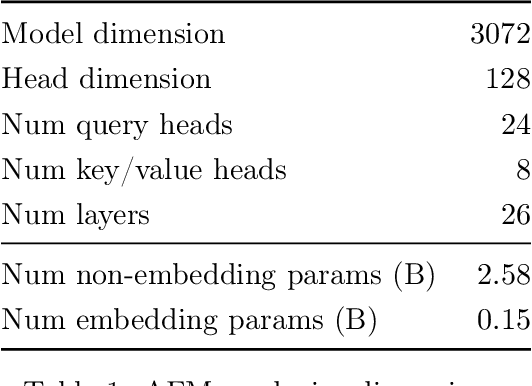
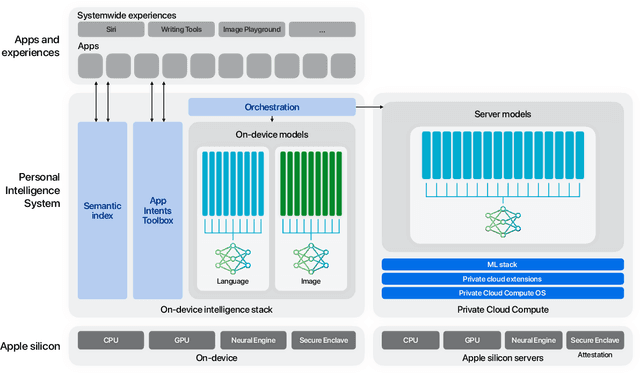

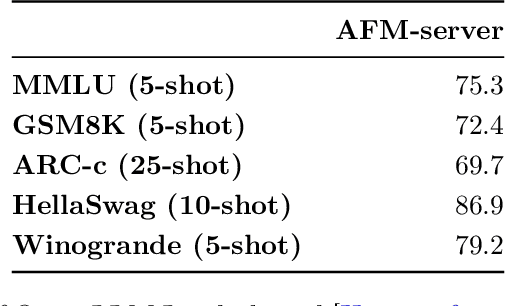
Abstract:We present foundation language models developed to power Apple Intelligence features, including a ~3 billion parameter model designed to run efficiently on devices and a large server-based language model designed for Private Cloud Compute. These models are designed to perform a wide range of tasks efficiently, accurately, and responsibly. This report describes the model architecture, the data used to train the model, the training process, how the models are optimized for inference, and the evaluation results. We highlight our focus on Responsible AI and how the principles are applied throughout the model development.
Ferret-UI: Grounded Mobile UI Understanding with Multimodal LLMs
Apr 08, 2024Abstract:Recent advancements in multimodal large language models (MLLMs) have been noteworthy, yet, these general-domain MLLMs often fall short in their ability to comprehend and interact effectively with user interface (UI) screens. In this paper, we present Ferret-UI, a new MLLM tailored for enhanced understanding of mobile UI screens, equipped with referring, grounding, and reasoning capabilities. Given that UI screens typically exhibit a more elongated aspect ratio and contain smaller objects of interest (e.g., icons, texts) than natural images, we incorporate "any resolution" on top of Ferret to magnify details and leverage enhanced visual features. Specifically, each screen is divided into 2 sub-images based on the original aspect ratio (i.e., horizontal division for portrait screens and vertical division for landscape screens). Both sub-images are encoded separately before being sent to LLMs. We meticulously gather training samples from an extensive range of elementary UI tasks, such as icon recognition, find text, and widget listing. These samples are formatted for instruction-following with region annotations to facilitate precise referring and grounding. To augment the model's reasoning ability, we further compile a dataset for advanced tasks, including detailed description, perception/interaction conversations, and function inference. After training on the curated datasets, Ferret-UI exhibits outstanding comprehension of UI screens and the capability to execute open-ended instructions. For model evaluation, we establish a comprehensive benchmark encompassing all the aforementioned tasks. Ferret-UI excels not only beyond most open-source UI MLLMs, but also surpasses GPT-4V on all the elementary UI tasks.
MM1: Methods, Analysis & Insights from Multimodal LLM Pre-training
Mar 22, 2024



Abstract:In this work, we discuss building performant Multimodal Large Language Models (MLLMs). In particular, we study the importance of various architecture components and data choices. Through careful and comprehensive ablations of the image encoder, the vision language connector, and various pre-training data choices, we identified several crucial design lessons. For example, we demonstrate that for large-scale multimodal pre-training using a careful mix of image-caption, interleaved image-text, and text-only data is crucial for achieving state-of-the-art (SOTA) few-shot results across multiple benchmarks, compared to other published pre-training results. Further, we show that the image encoder together with image resolution and the image token count has substantial impact, while the vision-language connector design is of comparatively negligible importance. By scaling up the presented recipe, we build MM1, a family of multimodal models up to 30B parameters, including both dense models and mixture-of-experts (MoE) variants, that are SOTA in pre-training metrics and achieve competitive performance after supervised fine-tuning on a range of established multimodal benchmarks. Thanks to large-scale pre-training, MM1 enjoys appealing properties such as enhanced in-context learning, and multi-image reasoning, enabling few-shot chain-of-thought prompting.
Controllable Music Production with Diffusion Models and Guidance Gradients
Nov 01, 2023Abstract:We demonstrate how conditional generation from diffusion models can be used to tackle a variety of realistic tasks in the production of music in 44.1kHz stereo audio with sampling-time guidance. The scenarios we consider include continuation, inpainting and regeneration of musical audio, the creation of smooth transitions between two different music tracks, and the transfer of desired stylistic characteristics to existing audio clips. We achieve this by applying guidance at sampling time in a simple framework that supports both reconstruction and classification losses, or any combination of the two. This approach ensures that generated audio can match its surrounding context, or conform to a class distribution or latent representation specified relative to any suitable pre-trained classifier or embedding model.
Mobile V-MoEs: Scaling Down Vision Transformers via Sparse Mixture-of-Experts
Sep 08, 2023



Abstract:Sparse Mixture-of-Experts models (MoEs) have recently gained popularity due to their ability to decouple model size from inference efficiency by only activating a small subset of the model parameters for any given input token. As such, sparse MoEs have enabled unprecedented scalability, resulting in tremendous successes across domains such as natural language processing and computer vision. In this work, we instead explore the use of sparse MoEs to scale-down Vision Transformers (ViTs) to make them more attractive for resource-constrained vision applications. To this end, we propose a simplified and mobile-friendly MoE design where entire images rather than individual patches are routed to the experts. We also propose a stable MoE training procedure that uses super-class information to guide the router. We empirically show that our sparse Mobile Vision MoEs (V-MoEs) can achieve a better trade-off between performance and efficiency than the corresponding dense ViTs. For example, for the ViT-Tiny model, our Mobile V-MoE outperforms its dense counterpart by 3.39% on ImageNet-1k. For an even smaller ViT variant with only 54M FLOPs inference cost, our MoE achieves an improvement of 4.66%.
Self Supervision Does Not Help Natural Language Supervision at Scale
Jan 20, 2023



Abstract:Self supervision and natural language supervision have emerged as two exciting ways to train general purpose image encoders which excel at a variety of downstream tasks. Recent works such as M3AE and SLIP have suggested that these approaches can be effectively combined, but most notably their results use small pre-training datasets (<50M samples) and don't effectively reflect the large-scale regime (>100M examples) that is commonly used for these approaches. Here we investigate whether a similar approach can be effective when trained with a much larger amount of data. We find that a combination of two state of the art approaches: masked auto-encoders, MAE and contrastive language image pre-training, CLIP provides a benefit over CLIP when trained on a corpus of 11.3M image-text pairs, but little to no benefit (as evaluated on a suite of common vision tasks) over CLIP when trained on a large corpus of 1.4B images. Our work provides some much needed clarity into the effectiveness (or lack thereof) of self supervision for large-scale image-text training.
Bias in Automated Image Colorization: Metrics and Error Types
Feb 16, 2022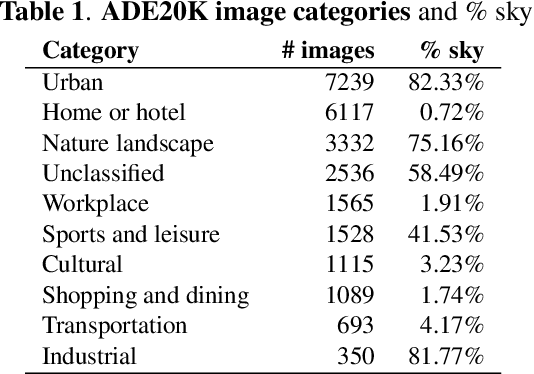
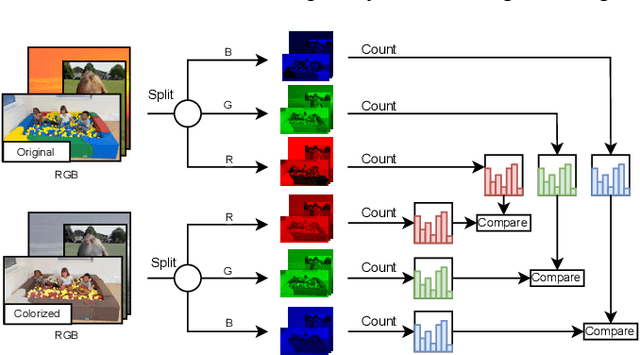
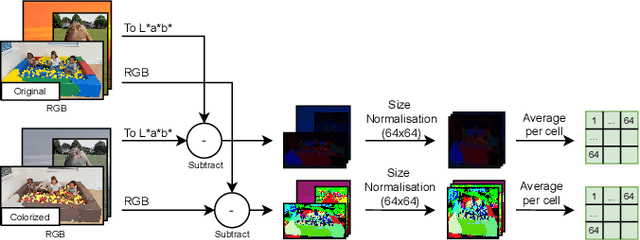
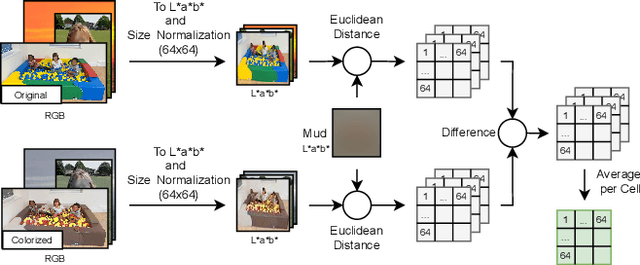
Abstract:We measure the color shifts present in colorized images from the ADE20K dataset, when colorized by the automatic GAN-based DeOldify model. We introduce fine-grained local and regional bias measurements between the original and the colorized images, and observe many colorization effects. We confirm a general desaturation effect, and also provide novel observations: a shift towards the training average, a pervasive blue shift, different color shifts among image categories, and a manual categorization of colorization errors in three classes.
 Add to Chrome
Add to Chrome Add to Firefox
Add to Firefox Add to Edge
Add to Edge